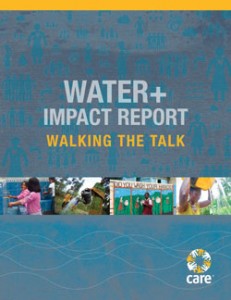CARE Water + Impact Report: Walking the Walk, 2013.
CARE.
Summary – CARE has provided water+ services to developing countries for over 55 years and is currently working on more than 180 such projects in over 40 countries. Throughout the years CARE has focused on both emergency response and long-term development; recently the organization has emphasized building the capacity of local institutions, strengthening community-led water resource management (WRM) and total sanitation, and adopting an integrated water resource management (IWRM) approach. 
PROGRESS AGAINST OUR THEORY OF CHANGE
In 2010 CARE USA’s water team developed a theory of change for our work in water. Our theory of change has been used as a measure of activities leading to impact in this report; however, a theory of change is one of many guides to understanding change and we are fully aware of its limitations. This report is based on a review of 51 reports, mostly mid-term or final evaluations dated between 2006 and 2012. A scoring tool was developed to score the reports against the three domains of the water+1 theory of change.
Domain 1: Secure and Sustainable Access to Water+ Services
Programming focused on provision of water, sanitation and access to hygiene facilities. On the whole CARE demonstrated excellent work in water, sanitation and hygiene (WASH), WRM and multiple uses of water; however, improvements are needed to strengthen sustainability and collaboration approaches. The mostcommon criticism of CARE’s programming was a lack of sustainability, many times caused by Inattentiveness to supportive factors such as access to supply chains or qualified technicians for repair. One evaluation showed the effects of CARE’s training had almost vanished 8 years after project completion.
Domain 2: Gender-Sensitive Water+ Policies, Institutions and Social Norms
CARE was scored on items such as deliberate influence of policy or policy implementation and community empowerment and capacity building. The evaluations revealed that CARE has done some strong work in strengthening community-based organizations and in working with government for increasing access to water+ programs. A major shortcoming is that these types of interventions are not consistent. Though the programs did promote behavior change and thus provided an avenue for re-shaping social norms, more could have been done to consistently analyze and evaluate existing norms and power relationships to influence and challenge social and political infrastructures to achieve change at a large scale.
Domain 3: Gender-Equitable Control over Water+ Services
Women living in traditional communities are not usually allowed to serve on public committees. Yet water committees give them a unique opportunity for leadership because water for domestic use is seen largely as the woman’s domain. Several evaluations noted results favorable to women and girls, including a decreased burden of fetching water, increased attendance of girls in school, a cleaner personal appearance and women having more authority in the community. On the other hand men are often seen to have a greater say when it comes to water for productive use; for example, the land and livestock benefiting from the water are more likely to be owned by heads of households who are still predominantly male.Few of the initiatives examined tools for analyzing social structures and power relations within communities, disaggregated benefits by gender or employed empowerment methodologies. CARE’s traditional strength in community organization is evident but should be leveraged for more ambitious, socially oriented approaches driven by empowerment objectives rather than solely water+ ones.
CASE STUDIES ON IMPACt AND APPROACHES
Ten case studies from within country offices and at global level showcase CARE’s efforts in making water+ services available to the poor. They demonstrate both impact and the approaches taken to reach that impact, highlighting strengths that varyingly correspond to one or more of the domains of the theory of change. For example, the case study from Madagascar documents the effective use of public-private partnerships in delivering secure and sustainable access to water+ services (domain 1), but the case study from Vietnam explores a community visioning approach to WRM that does justice to the individual and communal agency and empowerment-in-action spirit of domain 3 (gender-equitable control over water+ services). The global case studies on learning, partnership, advocacy and emergency WASH prove trickier to subject to the water+ theory of change lens, created as it was on a model of change within a country context where some element of direct implementation (domain 1) is presupposed. Nonetheless, collectively, these case studies highlight some strong achievements in a global picture.



